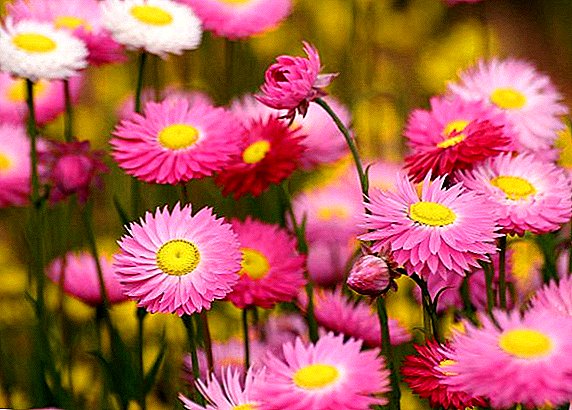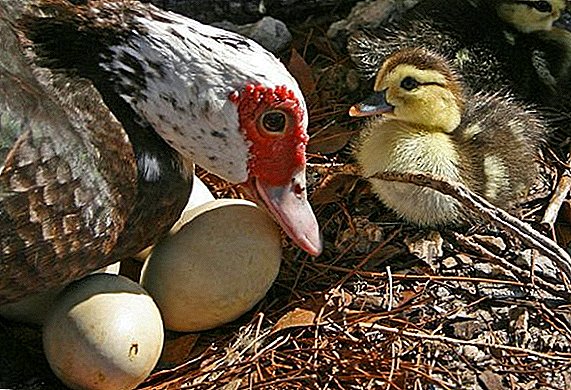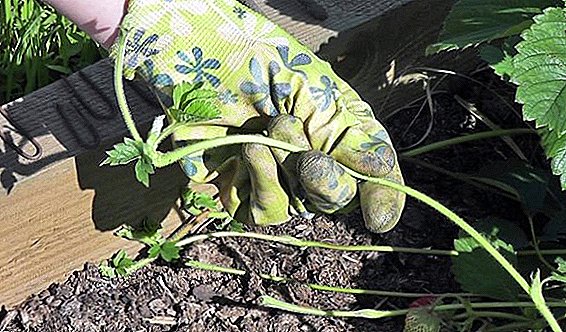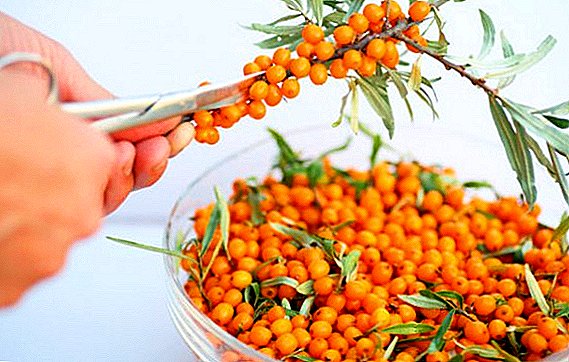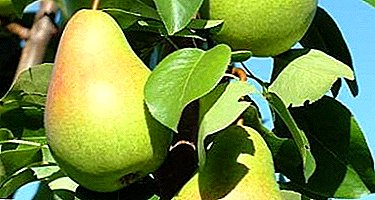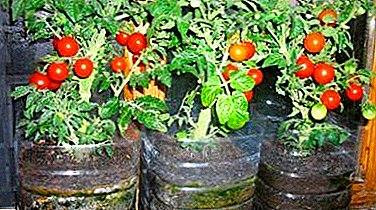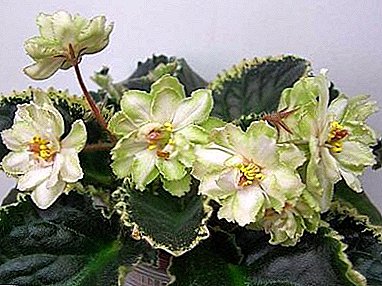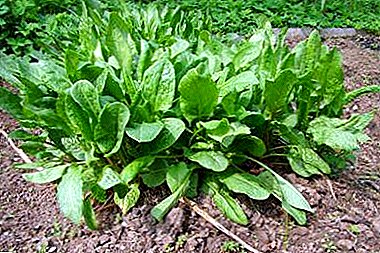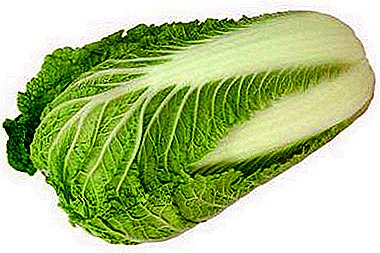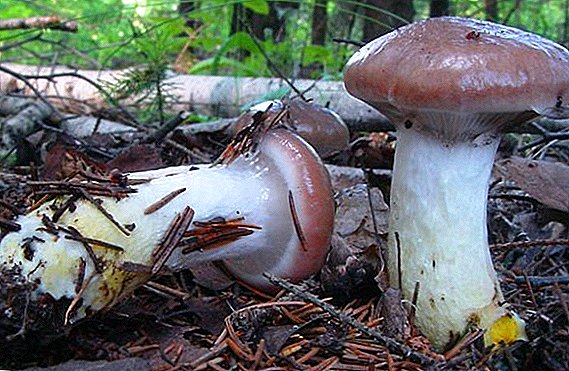 Mokruhi are a separate family of edible mushrooms, which is not very popular, and they are rarely eaten. Most likely, this is due to the unusual appearance or ignorance of many people who, seeing mokruhi in the forest, take them for toadstools. Today we will look at the main types of wet, their description, places of growth, so that in the future it will be easier for you to recognize them.
Mokruhi are a separate family of edible mushrooms, which is not very popular, and they are rarely eaten. Most likely, this is due to the unusual appearance or ignorance of many people who, seeing mokruhi in the forest, take them for toadstools. Today we will look at the main types of wet, their description, places of growth, so that in the future it will be easier for you to recognize them.
General characteristics of the family
The mokrukh family united in itself the genus Hrohomfus and the genus Homfidius. These mushrooms are called mokruhi due to the fact that they have a peculiarity of covering themselves with mucous membrane, and therefore their caps are always wet and slippery to the touch.
Thick mucous film characteristic of young mokrukha, over time it breaks and slips to the leg.
The mokrukh are lamellar fungi, the plates are planted with a rather large gap, the branched ones descending to the pedicle have a whitish tint, which in the process of growth of the fungus becomes almost black.  Young mokruhi characterized by convex or conical caps, which in the period of growth become prostrate and depressed in the center, with lowered fields.
Young mokruhi characterized by convex or conical caps, which in the period of growth become prostrate and depressed in the center, with lowered fields.
Color depends on the type and may be brown, gray, red, pink. Leg mokruhi dense, at the base it is yellow in color, to the cap becomes grayish-white.
Wet species
There are many types of wet, among which there are 4 of the most common in nature and popular among mushroom pickers:
- adhesive (spruce);
- purple (pine);
- mucous (spotty);
- pink
Consider the description of each species in more detail.
Spruce
This type is the most common, it is also called sticky mokruha.
The hat. The spruce mokruhi cap has a diameter of 3.5 to 13 cm, characterized by a hemispherical shape, the edges of which are strongly tucked to the leg. As the mokruhi grows up, the cap becomes conical, and at the last stage of growth acquires a flattened rounded shape, pressed in the center, at the place of attachment to the pedicle.  The cap has a smooth surface, which is covered with a thick mucous film. In the process of growth, the film rolls down. The color of the cap is gray, gray-blue or gray-brown, later it becomes purple along the edges, the middle fade. At the last stage of growth, black dots appear on the cap. The skin is dense and well removed from the cap in one motion.
The cap has a smooth surface, which is covered with a thick mucous film. In the process of growth, the film rolls down. The color of the cap is gray, gray-blue or gray-brown, later it becomes purple along the edges, the middle fade. At the last stage of growth, black dots appear on the cap. The skin is dense and well removed from the cap in one motion.
Did you know? In Switzerland, honeydew was found about 1000 years old. His mycelium is located on 35 hectares of national park area.
Records. The plates are arcuate, strongly branched and rather thick, about 6 mm wide. Their number per centimeter is not more than 10 pieces. The plates are slightly cream-colored, which gradually becomes darker and becomes brown. Plates of overripe mushrooms are represented by a dark brown shade.
Leg. The leg of the fungus grows high - from 6 to 8 cm, width from 1 to 2, 5 cm, it is thick in young mushrooms, after some time it takes the form of a cylinder. The surface is covered with soft dark scales, is characterized by a grayish color, at the base a greenish-yellow shade is visible. On the leg there is an inconspicuous ring of mucus, which decreases with time.
The flesh. The fungus is rather fleshy, its flesh is fragile, its color is light, slightly creamy, when cut it becomes pinkish. Older mushrooms are characterized by the gray color of the flesh. The taste is pleasant, it has light sweet, slightly sour notes, the smell is not very expressive, mushroom. 
Where is growing. Spruce moorie is often found in coniferous, spruce or mixed forest, it prefers to grow in moss, among heather, on the forest floor. This type of mushroom was widely spread in the north and center of Russia.
The period of spruce mockwort growth: July-October.
Is it possible to eat. The mushroom is classified as edible (category 4). Before eating mokruhu previously subjected to heat treatment.
Important! Under the influence of high temperature, the fungus acquires a dark color, but this does not affect its taste and nutritional value.
Spotty
This type of mokruuha has a smaller size, grows in groups.
The hat. Spotted mokrukha is characterized by a small cap (its diameter is from 3 to 7 cm); in young representatives of the species it is convex, after a while it becomes flattened with a tucked edge. From above the cap is covered with a thin layer of mucus. The cap is smooth, gray-ocher or gray-brown in color with small black spots.  Records. Plates from representatives of this type of light cream color, over time, acquire a dirty-brown tint. Between the plates are quite large gaps.
Records. Plates from representatives of this type of light cream color, over time, acquire a dirty-brown tint. Between the plates are quite large gaps.
Leg. Mokruhi leg in height from 5 to 11 cm and 2 cm in thickness, cylindrical, with a ring of mucus under the cap. The color of the legs is creamy, it is covered with small dark spots, yellowish at the bottom.
The flesh. The flesh of this type of cream color becomes red when cut. In the process of growth of the fungus becomes light brown. Mokrukha has a characteristic, weak mushroom smell, sweetish taste.
Where is growing. The fungus is found in spruce or mixed forests, selects places with a large number of moss or shrubs, mostly in areas where moisture is concentrated. This species is widely distributed throughout almost all of Eurasia and North America.
Growth period of spotted mokruhi: July-October.
Is it possible to eat. Mushrooms can be eaten, but must first be heat treated.
Purple
This species is also called a mucous membrane, a shiny mokruha, or a copper-red yellowstone.
The hat. A hat with a diameter of 4 to 12 cm, in a young mushroom, it is conical, rounded, with a characteristic web pattern of a light brown shade. Over time, it acquires a flat-convex or flat shape with a small tubercle in the center and strongly wrapped edges.  The peel on the cap is smooth, with glitter, for a young mushroom is characterized by a thick film of mucus. The cap may be light brown, pinkish at the beginning of the growth of the fungus, and over time it becomes more saturated dark color.
The peel on the cap is smooth, with glitter, for a young mushroom is characterized by a thick film of mucus. The cap may be light brown, pinkish at the beginning of the growth of the fungus, and over time it becomes more saturated dark color.
Records. The plates have an arcuate shape, are located at a great distance from each other, are painted in ocher-pink or mauve color, with time they turn purplish-brownish, at the end of maturation they become dark, almost black.
Did you know? The largest boletus was found in the USA in 1985: it had a weight of 140 kg, and in girth it reached 2 meters.
Leg. This part of mokruhi is not as long as in other species, its height is from 5 to 8 cm, thickness - from 0.5 to 2 cm, in the form of a cylinder, often curved. Under the cap on the stem there is a ring of mucus, which becomes less noticeable as the fungus grows. The color of the legs closer to the cap is reddish, the base is characterized by a rich yellow color.
The flesh. Mokruhah pulp has a pink-yellow color, the smell and taste of mild. If you cut the mushroom, the flesh becomes saturated pink.
Where is growing. There is a mushroom in coniferous and mixed forests, in elevated areas, often near pine trees. It grows well on calcareous soils. Mokruha purple widespread in Eurasia (northern part).
Growth period: August-October.  Is it possible to eat. Mokruhu purple belongs to the little-known edible fungus of the 4th category. It can be consumed after a brief heat treatment. The taste is similar to boletus, during cooking, the mushroom is painted in purple color, due to which it received such a name.
Is it possible to eat. Mokruhu purple belongs to the little-known edible fungus of the 4th category. It can be consumed after a brief heat treatment. The taste is similar to boletus, during cooking, the mushroom is painted in purple color, due to which it received such a name.
Find out what useful properties such mushrooms as have: flakefish, cheeses, shiitake mushrooms, reishi mushrooms, white heavy trucks, pigs, ceps, boletus, milk mushrooms, boletus mushrooms, chanterelles, boletus mushrooms, boletus and champignons.
Pink
Quite a rare species of wet, which is the smallest of the species in question.
The hat. The cap of this species grows from 3 to 6 cm, has a hemispherical shape, which becomes flatter during growth. The young mushroom is covered with a thick layer of mucus, which eventually rolls onto the leg. The color of the cap is pink-coral, with time it becomes brick, in the center - faded.  Records. The plates are located at a fairly long distance, at the initial stage of the fungus development they are painted in a light milky color, but after a while they become ash gray or dark gray.
Records. The plates are located at a fairly long distance, at the initial stage of the fungus development they are painted in a light milky color, but after a while they become ash gray or dark gray.
Leg. This part of the fungus is from 2 to 8 cm high and from 1 to 2.5 cm thick, in the form of a barrel, often curved, colored cream-white in color, often pinkish. A small ring of mucus is attached at the top of the foot.
The flesh. The flesh is characterized by white color, if cut, it becomes pink. It has a slightly perceptible pleasant smell, taste slightly subtle, sweetish.
Did you know? Fungal genes are closer to human than to plant genes.
Where is growing. The fungus settled in the boreal zone of the Eurasian continent, occasionally it can be found in the coniferous forest near the mountains. Growth period: August-October.
Is it possible to eat. Pink mokruukh allowed to use, but unpopular among the mushroom pickers, as they are rare. Like all other types of wet, pink wet hands require preliminary heat treatment before consumption. 
How to use mushrooms in cooking
Although the mocrux are rare on the table of an ordinary person, they are quite popular among mushroom pickers, as they have a pleasant taste and do not require long cooking.
Mokruhi can be eaten boiled, fried, baked, salted, pickled.
Read more about pickles, pickling, drying and freezing mushrooms.
They are used to make sauces, soups, main dishes, salads, omelets, sandwiches, they are served as a side dish to various dishes. Before cooking, these mushrooms must be cleaned from the mucous membrane, which can ruin the taste of the dish, creating an unattractive slimy "sauce".
To quickly cope with the task of cleaning, you need to wash the mushrooms well under running cold water, then cut the mushroom with a sharp knife in half and gently scrape off the sticky mask from the cap and legs.  After cleaning, the mushrooms are washed again, this time especially carefully, as the moor is growing mainly on sandy soil and a large amount of sand accumulates at the base of the foot, which is very difficult to wash.
After cleaning, the mushrooms are washed again, this time especially carefully, as the moor is growing mainly on sandy soil and a large amount of sand accumulates at the base of the foot, which is very difficult to wash.
Important! If you plan to fry or bake mushrooms, then you do not need to boil them beforehand. It is necessary to cook mokruhi not for long so as not to spoil the taste of the future dish. It will be enough heat treatment for 15-30 minutes.
Is there any benefit from wet
In the composition of modern professional cosmetics as one of the components can sometimes be found wet extract, which is added to creams and masks for fading skin. Funds based on them can make the skin smooth, supple and elastic, narrow pores. The skin at the same time becomes opaque, color is leveled, fine wrinkles are smoothed.
The positive effect of decoction on hair is also noted. With regular use of such funds, the hair becomes strong, gain a healthy shine, accelerates their growth.
In some types of moorky, the content of unique substances, which are often used for pharmacological purposes for the manufacture of antibiotics, is found.  There are also many recipes for traditional medicine using mokrukh as the main component of the medicine. Often it is alcohol tinctures or ointments that are effective for skin diseases, sinusitis, weak immunity, insomnia, and chronic migraines.
There are also many recipes for traditional medicine using mokrukh as the main component of the medicine. Often it is alcohol tinctures or ointments that are effective for skin diseases, sinusitis, weak immunity, insomnia, and chronic migraines.
Mokrukhi are well absorbed by the body, unlike other popular mushrooms, so they are recommended to be consumed during a strict diet - so you can quickly saturate the body, dull the feeling of hunger, which contributes to effective weight loss.
People who want to lose weight, you need to include in your diet: lagenaria, flax seeds, white radish, squash, cress, celery, radish, spinach, savoy or cauliflower.
Thus, mokruhi have many edible species. The main thing is to remember the special features of each type, to properly distinguish them and to observe all the details of cooking, in order to get a tasty and healthy dish.


